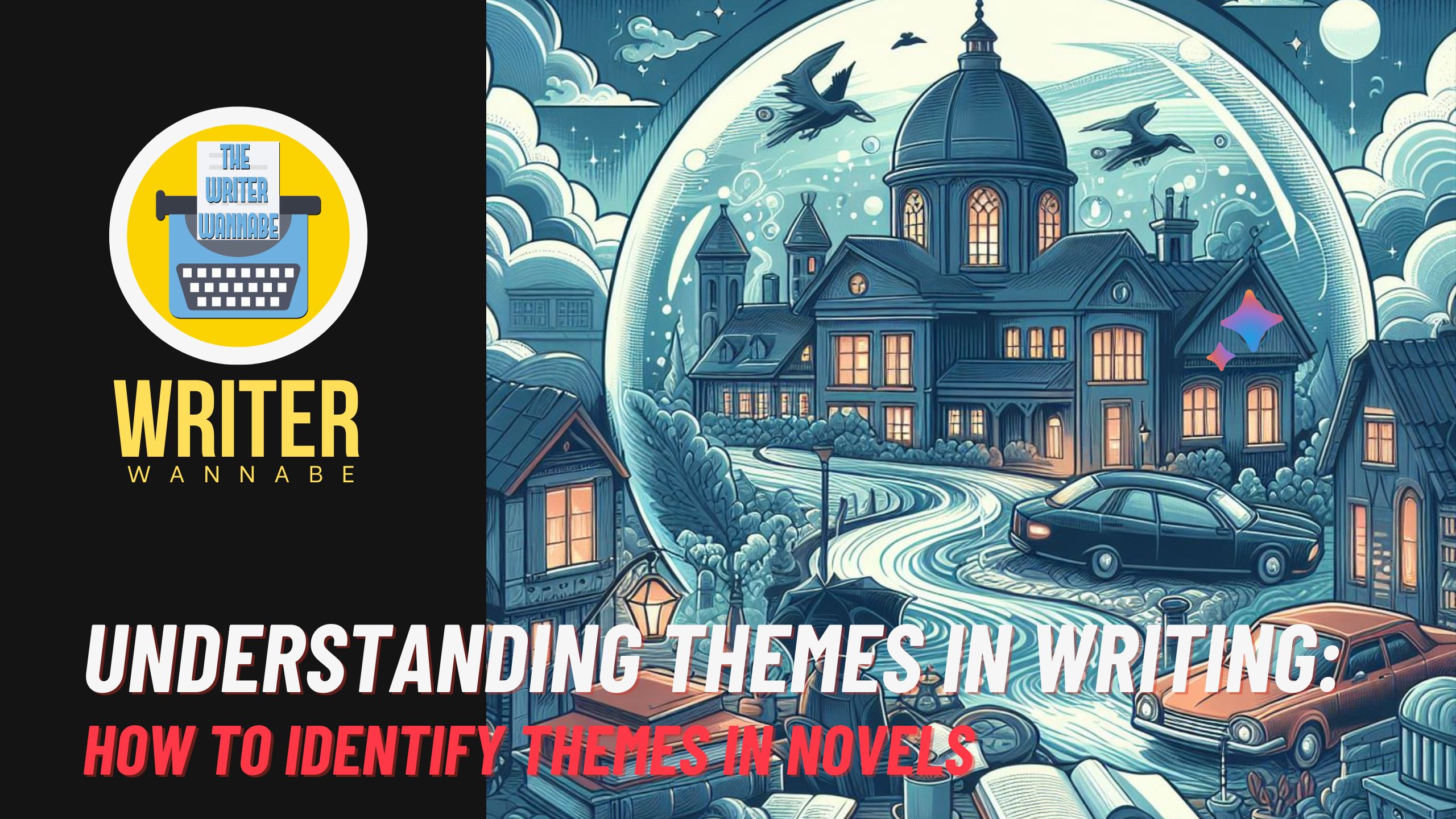Understanding common Themes in literature: How to Identify Themes in Novels
Identifying themes in a published work is an important skill for readers and writers alike. Themes provide deeper meaning and insight into the story, characters, and ideas presented in a literary work. Understanding the themes of a text enhances the reader’s engagement and allows writers to craft more profound and influential narratives. In this blog post, we will explore How to Identify Themes in Novels, its importance and provide an overview of the process to identify themes.
Contents: How to Identify Themes in Novels

How to Identify Themes in Novels
Importance of Identifying Themes in Novels
Identifying themes in novels is crucial for several reasons:
1. Connection with the reader: Themes allow readers to connect with the story on a deeper level. When readers relate to the themes explored in a novel, they become emotionally invested in the characters and their journeys.
2. Insight into the human condition: Themes often reflect universal truths and insights about the human experience. They delve into topics such as love, loss, power, identity, and more. By identifying these themes, readers gain a better understanding of themselves and others.
3. Enhanced literary analysis: Themes provide a framework for analyzing the literary elements of a novel. Readers can analyze how the plot, characterization, setting, tone, and style contribute to the overall message and purpose of the work by grasping the central themes..
4. Guidance for writers: For writers, understanding themes in novels is essential for crafting stories that resonate with readers. By identifying themes, writers can create more cohesive narratives, develop complex characters, and explore meaningful ideas.
Overview of the Process to Identify Themes in Novels
Identifying themes in a novel requires a careful analysis and interpretation of the text. Here is a step-by-step process to help you identify themes:
1. Read the text: Begin by reading the novel carefully, paying attention to the plot, characterization, setting, tone, and style. Take note of any recurring ideas, symbols, or motifs.
2. Reflect on the story: After reading, take some time to reflect on the story’s overarching message and what the author may be trying to convey. Consider the characters’ journeys, conflicts, and resolutions.
3. Identify key ideas: Look for patterns and recurring ideas throughout the novel. Consider the themes explored in relation to the plot events, character relationships, and the overall meaning of the story.
4. Consider author’s purpose: Think about why the author chose to write about these themes. Consider the historical, social, or cultural context in which the novel was written and how it might influence the themes.
5. Analyze supporting evidence: Look for specific evidence in the text that supports the identified themes. This can include direct statements, character dialogue, symbolism, and motifs.
6. Refine and articulate the themes: Once you have identified the key themes and gathered supporting evidence, refine your understanding of them and articulate them in a clear and concise manner. Themes should be broad enough to encompass the story’s core concepts while remaining specific enough to provide meaningful insight.
By following this process, readers and writers can effectively identify and understand the themes present in a novel. This deeper understanding enhances the reading experience and allows for more impactful storytelling. So, next time you read a published work, take the time to identify the themes and uncover the hidden layers of meaning within the story.

Read and Analyze the Novel
Steps to understanding the plot and characters
To identify and analyze themes in a published work, it is essential to start by thoroughly reading and analyzing the novel. Here are some steps to help you understand the plot and characters:
1. Begin by reading the novel: Before attempting to identify themes, make sure you have read the entire work. Familiarize yourself with the storyline, characters, and events.
2. Take note of the plot: Write down the main events and conflicts in the novel. Pay attention to the structure of the plot, including the exposition, rising action, climax, falling action, and resolution.
3. Examine the characters: Analyze the main characters’ personalities, motivations, and relationships. Take note of their development throughout the novel and how they contribute to the overall story.
Analyzing the literary elements: plot, characterization, setting, tone, and language style
To identify themes, it is crucial to analyze various literary elements present in the novel. Here are some elements to focus on:
1. Plot: Consider the main actions and events that drive the story forward. Look for patterns or recurring themes within the plot.
2. Characterization: Pay attention to how the author presents the characters. Analyze their traits, behaviors, and motivations. Look for any conflicts or transformations that the characters undergo.
3. Setting: Examine the time, place, and atmosphere depicted in the novel. The setting can influence the themes of the work and provide valuable context.
4. Tone: Analyze the author’s tone and attitude towards the subject matter. Consider whether the tone is serious, humorous, ironic, or sentimental. The tone can provide clues about the themes the author is exploring.
5. Language style: Take note of the author’s writing style. Analyze the use of literary devices such as metaphors, similes, and symbolism. Pay attention to the use of descriptive language and dialogue.
By thoroughly analyzing these literary elements, you can gain a deeper understanding of the novel and uncover its underlying themes. This process will help you develop your analytical skills and write in-depth analyses for better grades.
Remember, identifying and analyzing themes in texts is a skill that becomes increasingly important as you progress through your senior high school years. To make it easier for you, download our free step-by-step planner to guide you through the process. With practice, you will become more confident in your ability to identify and analyze themes in any text you encounter.

Identify Common Subjects Theme of a story
Exploring common subjects in novels
In order to understand the themes in a published work, it is important to first identify the common subjects that are often explored in novels. These subjects provide a foundation for the themes and can help readers relate to and connect with the story. Here are some common subjects often found in literature:
1. Coming of age: Many novels depict the journey of a young protagonist as they navigate the transition from childhood to adulthood. This subject explores themes of self-discovery, growth, and the challenges of growing up.
2. Death and mourning: Death is a universal human experience, and many novels delve into the themes of loss, grief, and the process of mourning. These works often explore the impact of death on individuals and communities.
3. Racism: Racism and racial discrimination continue to be important social issues, and many novels address this subject matter. These works explore themes of prejudice, inequality, and the effects of racism on individuals and societies.
4. Beauty: The concept of beauty is often explored in literature, examining its subjective nature and societal standards. Themes related to beauty can include self-acceptance, the dangers of superficiality, and the power of inner beauty.
5. Heartbreak and betrayal: Love and relationships are a common subject in literature, and themes of heartbreak and betrayal often arise. These works explore the devastating effects of betrayal and the complexities of human emotions.
6. Loss of innocence: The loss of innocence is a recurring theme in literature, representing the moment when a character becomes aware of the harsh realities of the world. This subject explores themes of disillusionment, growth, and the loss of childhood innocence.
7. Power and corruption: Many novels delve into the abuse of power and the corrupting influence it can have on individuals and society. These works often explore themes of morality, justice, and the consequences of unchecked power.
By identifying these common subjects, readers can gain insight into the themes that may be explored in a novel. This can help create a deeper understanding and appreciation for the work.
Discussing subjects like love, friendship, power, identity, and social issues
In addition to the common subjects mentioned above, there are several other subjects that often appear in literature. These subjects can provide a rich source of themes and provoke thought and discussion among readers. Here are some additional subjects commonly explored in novels:
1. Love: Love is a universal theme that appears in various forms in literature. It can explore the complexities of romantic relationships, familial love, platonic love, and self-love. Themes related to love can include sacrifice, forgiveness, and the power of love to overcome obstacles.
2. Friendship: The bonds of friendship are often depicted in novels, exploring themes of loyalty, trust, and the importance of connection. These works celebrate the power of friendship and the impact it can have on individuals’ lives.
3. Power: The subject of power can encompass various aspects, such as political power, social power, or personal power. Novels that explore power often delve into themes of corruption, abuse, and the struggle for power.
4. Identity: Identity is a complex subject explored in literature, examining questions of self-discovery, self-acceptance, and the influence of societal expectations. These works often explore themes of identity formation, cultural identity, and the search for one’s true self.
5. Social issues: Literature has long been a medium for social commentary, tackling important social issues such as poverty, inequality, discrimination, and injustice. These works often aim to raise awareness, provoke thought, and inspire change.
By recognizing and discussing these subjects, readers can gain a deeper understanding of the themes explored in a novel. This can lead to more insightful analysis and interpretation of the work.

Consider the Author’s Perspective
One crucial aspect of analyzing a novel is considering the author’s perspective. Understanding the author’s point of view, beliefs, and values can provide valuable insights into the themes and messages conveyed in the work. Here are some steps to help assess the author’s perspective:
Assessing the author’s point of view towards the characters and their choices
When analyzing a novel, it is essential to examine the author’s point of view towards the characters and their choices. This can provide insights into the author’s perspective on various themes such as morality, human nature, and societal norms. Here are a few steps to consider:
1. Look for direct characterization: Examine how the author presents the characters through their actions, thoughts, and dialogue. Analyze whether the author portrays them positively, negatively, or neutrally.
2. Analyze character arcs: Pay attention to the development and transformation of the characters throughout the story. Consider how their choices and experiences align with the author’s perspective on certain themes.
3. Identify the author’s biases: Authors may have certain biases or beliefs that influence their portrayal of characters. Look for any patterns or stereotypes in how the characters are depicted.
Understanding the author’s beliefs and values
In addition to analyzing the author’s perspective on the characters, it is essential to also consider their beliefs and values. Here are a few steps to help understand the author’s worldview:
1. Analyze the novel’s themes: Identify the central themes and messages conveyed throughout the novel. Consider how these themes align with the author’s beliefs and values.
2. Examine the author’s background: Research the author’s life and background to gain insights into their perspectives and experiences. Consider how these factors may have influenced their writing.
3. Consider the historical and cultural context: Think about the historical and cultural context in which the novel was written. Analyze how societal values and beliefs of that time may have influenced the author’s perspective.
By carefully assessing the author’s point of view towards the characters and understanding their beliefs and values, you can gain a deeper understanding of the themes and messages conveyed in the novel. This analysis will enable you to write more comprehensive and insightful essays that delve into the author’s intentions and the impact of their choices on the reader’s perception of social values. Remember to weave the assessment of views and values throughout your close analysis essay, rather than superficially adding a few lines at the conclusion.

Analyze Symbols and Motifs of common themes in literature
Recognizing symbols and motifs in the novel
To analyze a novel effectively, it is important to identify and understand the symbols and motifs present within the text. Symbols are objects, characters, or elements in the story that represent abstract ideas or concepts. On the other hand, motifs are recurring structures, images, or ideas that help develop the themes and advance the plot.
Here are some steps to help recognize symbols and motifs in a novel:
1. Pay attention to repetition: Look for elements that appear repeatedly throughout the story. These could be objects, images, or phrases that hold symbolic meaning or contribute to the development of a motif.
2. Consider the author’s emphasis: Think about the elements that the author highlights or gives particular importance to. These could indicate their significance as symbols or motifs.
3. Analyze patterns and connections: Look for patterns or connections between different elements in the story. These connections can help reveal underlying themes and messages.
Discussing their significance in revealing themes
Once you have identified the symbols and motifs in the novel, it is important to discuss their significance in relation to the themes of the story. Understanding how these symbols and motifs contribute to the overall meaning of the work enhances your analysis. Here are some steps to help in this analysis:
1. Connect symbols and motifs to themes: Analyze how the symbols and motifs relate to the major themes in the novel. Consider how they reinforce or challenge these themes, and what insights they provide into the author’s perspective.
2. Examine character interactions: Look at how the characters interact with the symbols and motifs. Consider how their interactions with these elements reflect their own development and the progression of the story.
3. Explore the symbolism’s impact on the plot: Investigate how the symbols and motifs drive the plot forward or impact the events in the story. Examine how their presence or absence influences the characters’ decisions and the overall narrative.
By analyzing the symbols and motifs in a novel and discussing their significance in revealing themes, you can gain a deeper understanding of the author’s intentions and the underlying messages in the work. This analysis provides valuable insights for essay writing, allowing you to explore the complexity of the story and its thematic elements. Remember to support your analysis with evidence from the text and to consider the broader context in which the novel was written.

Examine Character Development
Analyzing the growth and changes in the characters
One of the key aspects of understanding a novel is examining the growth and changes in the characters throughout the narrative. By analyzing how the characters develop, it becomes possible to gain insights into the underlying themes and messages conveyed by the author. Here are some steps to help assess character development:
1. Pay attention to the character’s thoughts, words, and behavior: To identify character growth, it is important to observe how their thoughts, words, and behavior change over time. Look for instances where the character’s traits evolve or transform as the story progresses.
2. Consider the role of the plot: The plot plays a crucial role in character development. It is through the events and conflicts in the narrative that characters are often challenged or face obstacles that lead to growth. Analyze how the plot contributes to the changes in the characters.
3. Look for key life-changing experiences: Characters often undergo significant experiences that shape their development. These experiences can be positive or negative and may involve personal discoveries, overcoming challenges, or learning important life lessons. Identify these pivotal moments in the story.
Understanding how their development contributes to the themes
Character development is closely tied to the themes explored in a novel. The growth and changes in characters often serve to highlight or explore these themes in greater depth. Here are some steps to understand the connection between character development and themes:
1. Identify the central themes: Analyze the main themes or ideas conveyed in the narrative. Consider how the characters’ development aligns with these themes. Are they struggling with similar issues or undergoing similar transformations?
2. Look for symbolism or motifs: The author may use symbolism or recurring motifs to reinforce the connection between character development and themes. Pay attention to objects, settings, or recurring ideas that may represent deeper meanings related to the themes.
3. Analyze character arcs: Character arcs refer to the journey a character undergoes from the beginning to the end of the story. Consider how the character’s development contributes to the overall arc and how it relates to the central themes.
By examining the growth and changes in the characters and understanding how their development contributes to the themes, readers can gain a deeper understanding of the novel. This analysis enables a more comprehensive interpretation and exploration of the author’s intentions and the impact of their choices on the reader’s perception of the narrative. Remember to support your analysis with specific evidence from the text and to consider the nuances and complexities of the characters’ development throughout the story.

Evaluate Relationships and Interactions
Examining the relationships between characters
Another crucial aspect of analyzing a novel is evaluating the relationships between characters. The interactions and dynamics between characters can provide valuable insights into the themes and messages explored by the author. Here are some steps to help evaluate relationships:
1. Identify key relationships: Identify the significant relationships in the story. This includes relationships between family members, friends, romantic partners, or even adversaries. Pay attention to how these relationships evolve and change throughout the narrative.
2. Analyze the nature of the relationships: Assess the nature of the relationships between characters. Is it based on love, trust, friendship, or conflict? Look for moments of connection, tension, or growth within these relationships.
3. Consider the impact of the relationships on the characters: Relationships can have a profound impact on the development of characters. They can shape their beliefs, values, and actions. Analyze how certain relationships affect the characters’ growth and how this contributes to the overall themes.
Exploring how these interactions reflect and contribute to the themes
The interactions between characters often reflect and contribute to the themes explored in a novel. By examining these interactions, readers can gain a deeper understanding of the underlying messages conveyed by the author. Here are some steps to explore the connection between interactions and themes:
1. Identify recurring patterns or conflicts: Look for recurring patterns or conflicts in the interactions between characters. These patterns may reveal deeper themes such as power dynamics, inequality, love, or betrayal. Analyze how these patterns contribute to the overall themes.
2. Analyze the dialogue and communication: Pay close attention to the dialogue and communication between characters. The way they communicate can provide insights into their relationships and the themes being explored. Look for instances of miscommunication, hidden meanings, or symbolism in their interactions.
3. Consider the external influences: Characters’ interactions are often influenced by external factors such as societal norms, cultural expectations, or historical events. Analyze how these external influences shape the characters’ relationships and contribute to the themes.
By evaluating the relationships between characters and exploring how these interactions reflect and contribute to the themes, readers can gain a deeper understanding of the novel. This analysis allows for a more nuanced interpretation of the author’s intentions and the impact of their choices on the reader’s perception of the narrative. Remember to support your analysis with specific evidence from the text and to consider the complexities and intricacies of the relationships and interactions portrayed in the story.
In conclusion, examining character development, evaluating relationships and interactions, and understanding their contribution to the themes are essential steps to analyzing a novel. By carefully considering these elements, readers can uncover deeper layers of meaning and gain a comprehensive understanding of the narrative.

Look for Patterns and Repetition
Identifying patterns and repetitions throughout the novel
Another valuable method for uncovering the themes in a novel is to look for patterns and repetitions throughout the text. These patterns can provide insight into the recurring concepts or ideas that the author intends to emphasize. Here are some steps to help identify patterns and repetitions:
1. Pay attention to recurring symbols or images: Symbols are objects, actions, or characters that represent deeper meanings. Look for symbols that appear multiple times throughout the story. Consider their significance and how they contribute to the overall themes.
2. Notice repeated phrases or words: Certain phrases or words that are repeated throughout the novel can also serve as indicators of themes. Pay attention to words or phrases that stand out and appear frequently. Examine their context and analyze their potential significance.
3. Analyze the structure of the novel: The organization and structure of the novel can also reveal patterns and repetitions. Look for recurring motifs, narrative devices, or stylistic choices that occur consistently. Consider how these structural elements contribute to the themes.
Discussing their role in reinforcing the themes
Once patterns and repetitions are identified, it is important to discuss their role in reinforcing the themes of the novel. Here are some points to consider:
1. Determine the significance of the patterns: Analyze the patterns and repetitions in relation to the themes of the novel. Consider how these patterns enhance the understanding of the themes or provide additional layers of meaning.
2. Explore variations in the patterns: Look for variations within the patterns or repetitions. Are there any subtle changes or developments that occur over time? These variations may offer insights into the complexities of the themes and add depth to the overall interpretation.
3. Consider the author’s intentions: Reflect on the author’s purpose in using these patterns and repetitions. What message or idea is the author trying to convey? How do these patterns contribute to the overall message of the novel?
By examining the patterns and repetitions in a novel and discussing their role in reinforcing the themes, readers can gain a deeper understanding of the underlying messages and ideas. This analysis allows for a more nuanced interpretation of the text and provides valuable insights into the author’s intentions. It is important to support your observations with specific examples from the text to strengthen your analysis.
In conclusion, examining character development and identifying patterns and repetitions are two effective strategies for uncovering the themes in a novel. By analyzing the growth and changes in the characters and exploring the significance of patterns and repetitions, readers can gain a more comprehensive understanding of the author’s intended themes. These strategies help to uncover the deeper layers of meaning and contribute to a richer interpretation of the novel. Remember to approach the analysis with an open mind, considering the nuances and complexities of the text, and support your observations with evidence from the novel.
Themes Examples: List of themes in literature
Below are some examples of themes commonly used in the literature:
- Love and Friendship: Love and friendship are universal themes that connect us all. They speak to our deepest longings and remind us of our shared humanity. Stories of love conquer all and friendships that endure through adversity resonate across languages and cultures.
- Good vs. Evil: The battle between good and evil represents the conflicts we face in the world and within our own souls. These timeless struggles for power echo through myths and legends as heroes choose honor in the face of darkness.
- Coming of Age: Coming of age stories capture the magic and angst of growing up. We relive our own transitions from childhood to adulthood through the eyes of characters taking their first steps towards independence and identity.
- Survival: Survival against impossible odds exemplifies the resilience of the human spirit. Whether stranded in nature or lost in a dystopian landscape, characters that overcome adversity demonstrate hope rising from despair.
- Identity: Identity themes examine how we view ourselves and how society shapes us. Revelations about one’s roots, transformations of personality, and crises of purpose all revolve around that essential question: “Who am I?”
- Power and Corruption: Power and corruption often go hand in hand in stories examining leadership and morality. The ethical use of influence is tested when greed and ambition enter the fray, leading heroes on journeys from righteousness to ruin.
- War and Peace: War and peace illustrate both the heights of human compassion and the depths of cruelty we inflict. Tales set against the backdrop of conflict show truth as the first casualty while those celebrating truces reveal our capacity for understanding.
- Freedom and Oppression: The longing for freedom beats in the heart of every oppressed soul crying out for liberation. Conversely, stories about breaking chains warn that license can itself become a type of binding lawlessness.
- Loss and Grief: Loss and grief are woven into the fabric of our mortal existence. By bearing witness to suffering characters, we make their pain our own and relearn the lessons of living when shadows fall.
- Nature and the Environment:Our connection to nature reflects our relationship with all living things. Whether stifled in cities of concrete or thriving in pastoral harmony, ties to the land shape personality.
- Justice and Injustice: Seeking justice in an unjust world is the quest of righteous heroes confronting corrupt systems with ethical courage. However, notions of morality often have blurred lines between vengeance and vindication.
- The Quest for Meaning: The search for life’s meaning underpins tales of existential questioning filled with equal parts wonder and dismay about our purpose beyond the mundane.
- Heroism: The heroic journey is a tale as old as antiquity, beginning when an ordinary individual hears the call to adventure. What ensues is a quest requiring courage, sacrifice and perseverance in the face of adversity until the prize is finally won.
- Alienation and Isolation: Alienation cuts to the bone of existence by imposing isolation upon characters who find themselves bewilderingly alone. Whether exiled emotionally, geographically or spiritually, their journeys map the anguish of estrangement.
- The Search for Truth: Discovering elusive, hidden truths often propels the momentum of revelation in mysteries simmering with secrets. However, what is ultimately learned frequently challenges more perceptions than it settles about reality underneath the lies.
- Betrayal: There is no sharper sting than the betrayal of trust by those held most dear. When camaraderie turns into conspiracy, the grief of loss mixes with a bewildering sense of injustice at old bonds abruptly broken.
- Redemption: On the path to redemption, shadowy heroes emerge from dark deeds into the light through remorse, atonement and renewed purpose. Their salvation lies not just in the sins left behind but the hope shining ahead.
- Prejudice and Discrimination: Prejudice chains both oppressor and oppressed behind bars of hatred that cloud common humanity. However, the courageous pursuit of empathy opens doors to enlightenment and equality.
- Family and Relationships: From ancestral legacies to sibling squabbles, families provide the framework of identity for better and worse as characters come to terms with their origins. Their development depends upon eventually finding affection despite domestic dysfunction.
- The Human Condition: Family and Relationships: Our shared condition connects across the collected experience of humankind. Though identities may vary dramatically, by giving voice to private dilemmas we find universal strands uniting us in our common lot as thinking, feeling beings who hope, hurt and dream.
Conclusion How to Identify Themes in Novels
Summarizing the process of identifying themes in novels
In conclusion, identifying themes in novels requires a close reading and interpretation of the text. By examining character development, readers can uncover the underlying ideas and messages that the author intends to convey. Additionally, looking for patterns and repetitions throughout the novel can provide valuable insights into the recurring concepts or ideas that contribute to the themes. Analyzing the significance of these patterns and discussing their role in reinforcing the themes allows for a deeper understanding of the novel.
Importance of understanding themes in enhancing the reading experience
Understanding themes in novels is essential for enhancing the reading experience. By identifying and analyzing the themes, readers can become emotionally and cognitively invested in the narrative, transforming their reading experience into a journey of deep introspection and self-discovery. Themes provide a framework for readers to explore and connect with the literature, allowing for a more meaningful and engaging reading experience. Furthermore, understanding themes can also help readers to relate the literature to the real world, providing insights and perspectives that can be applied to their own lives.
In conclusion, the process of identifying themes in novels involves close reading, interpretation, and analysis. By examining character development and identifying patterns and repetitions, readers can uncover the underlying messages and ideas that the author intends to convey. Understanding themes is crucial for enhancing the reading experience and fostering a deeper connection with the literature. By engaging with the themes, readers can embark on a transformative journey of self-discovery and gain a deeper understanding of the human experience. So next time you pick up a novel, remember to pay attention to the themes and explore the rich layers of meaning that lie beneath the surface.
Frequently Asked Questions ( FAQ) How to Identify Themes in Novels
What are the 3 steps to find themes in a novel?
To find the theme of a story, you first need to identify the story’s theme. Then, you’ll want to consider the main character and the moral or main idea that the story expresses. Finally, you can analyze these elements and find similar themes throughout a story.
How do you identify a story’s theme?
You can identify a story’s theme by asking yourself what the story is about and what lesson the main character learns throughout the tale. This will help you discover the central idea or the universal message that the author wants to express.
Can you provide examples of themes found in novels?
Certainly! Some examples of themes in novels include the theme of love, friendship, betrayal, courage, survival, justice, or the human experience. These themes are usually the main concepts that the author consciously weaves throughout the story.
Why is it important to find the theme of a novel?
Understanding the themes in novels is important as it helps readers comprehend the underlying message the author is trying to convey. It also enhances the reader’s experience and comprehension of the story as a whole.
How can themes help in creative writing?
Themes can help in creative writing by allowing authors to express a specific message or moral in their work. It can also guide the development of the plot and characters within the story.
Are themes only relevant to fiction or can they be found in nonfiction as well?
Themes are not exclusive to fiction; they can also be found in nonfiction. Just like in fiction, nonfiction can also contain universal messages and lessons about life, humanity, and the world we live in.
Why might someone find trouble understanding themes in a novel?
Some individuals might find trouble understanding themes in novels due to varying interpretations or a lack of familiarity with analyzing literary elements. However, with guidance and practice, most people can overcome this challenge.
Is it common to discover more than one theme in a single novel?
Yes, it is common to find multiple themes in a single novel. Authors often incorporate various themes to convey different aspects of the story, which can offer readers a richer and more profound reading experience.
Can themes emerge from every chapter of a novel or just at certain points?
Themes can emerge throughout a novel, not necessarily restricted to specific chapters. The author uses various storytelling elements, such as dialogue, setting, and character interactions, to convey the themes across the entire narrative.
How does understanding themes in writing benefit everyone, including readers and writers?
Understanding themes in writing benefits everyone by providing insight into the human experience and connecting individuals through shared lessons and knowledge. For readers, it enhances their comprehension and enjoyment of literature, while writers can use themes to craft impactful and meaningful narratives.
What is the definition of a literary theme?
A: A literary theme is an idea or concept that can be found in a work of literature. It is often a recurring, unifying subject or idea that can be observed throughout the entire work.
How do I identify a theme in a novel?
A: To identify a theme in a novel, pay attention to the events of the story, the characters’ actions and decisions, and the overall message or lesson conveyed by the author. Themes are often reflected in the plot points and the thematic statement of the story.
Can you provide some examples of common themes in literature?
A: Some common themes in literature include good and evil, love and friendship, the theme of power, the theme of survival, gender roles, and many others. These themes are often explored in various forms in different literary works.
What is a thematic statement?
A: A thematic statement is a complete sentence that expresses the main idea or message of a literary work. It goes beyond simply identifying a theme and presents a specific interpretation or insight about the theme of the work.
Why do writers use themes in their work?
A: Writers use themes to explore universal truths about the human experience, to convey important messages or moral lessons, and to provoke thought and reflection in their readers. Themes make the work more meaningful and relatable to the audience.
How can I start with a theme when I want to write a story?
A: When you want to write a story, you can start with a theme by choosing a particular theme that you want to explore or convey through your writing. This theme can serve as the guiding principle around which you build the plot, characters, and events of your story.
Can you provide a list of themes commonly found in literature?
A: Some common themes found in literature include love and friendship, good vs. evil, the power of nature, the journey of self-discovery, the conflict between tradition and modernity, the impact of war, the pursuit of dreams, and the complexity of human relationships, among others.
How does a theme differ from the events of the story?
A: A theme is a central idea that underlies the events of a story, whereas the events of the story refer to the specific incidents, actions, and developments that occur within the plot. The theme is the broader message or concept, while the events are the particular occurrences that drive the plot forward.
What happens at the end of the novel often reflects the theme. How so?
A: The conclusion of a novel often reflects the theme as it ties together the various elements of the plot to convey the overall message or lesson intended by the author. The resolution of the story and the ultimate fate of the characters may illustrate or reinforce the theme that has been developed throughout the narrative.
How is a particular theme conveyed in a work of literature?
A: A particular theme is conveyed in a work of literature through the portrayal of characters, the development of the plot, the language used, and the author’s overall storytelling choices. Through these elements, the theme is woven into the fabric of the narrative to create a coherent and meaningful exploration of the chosen theme.








